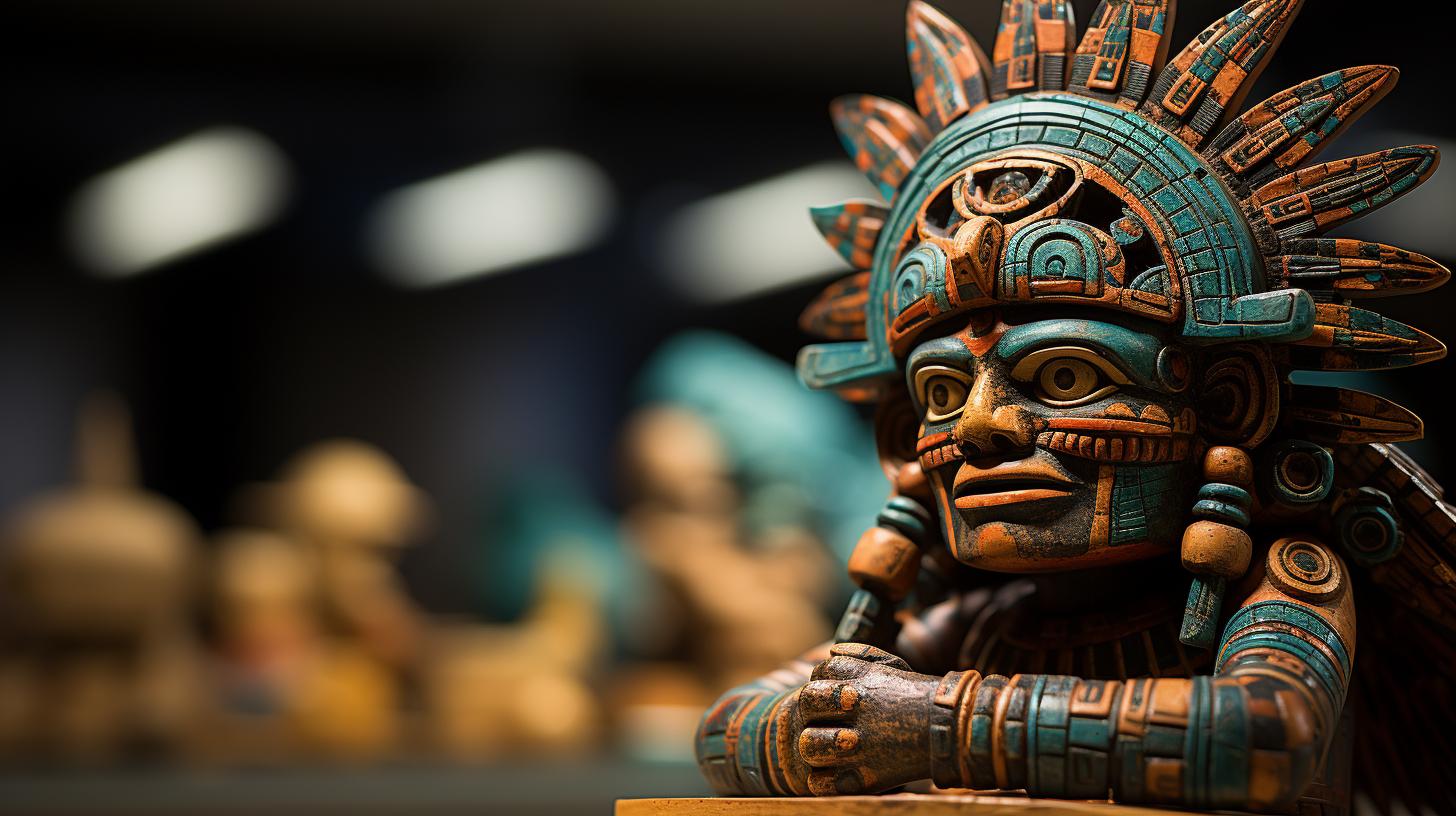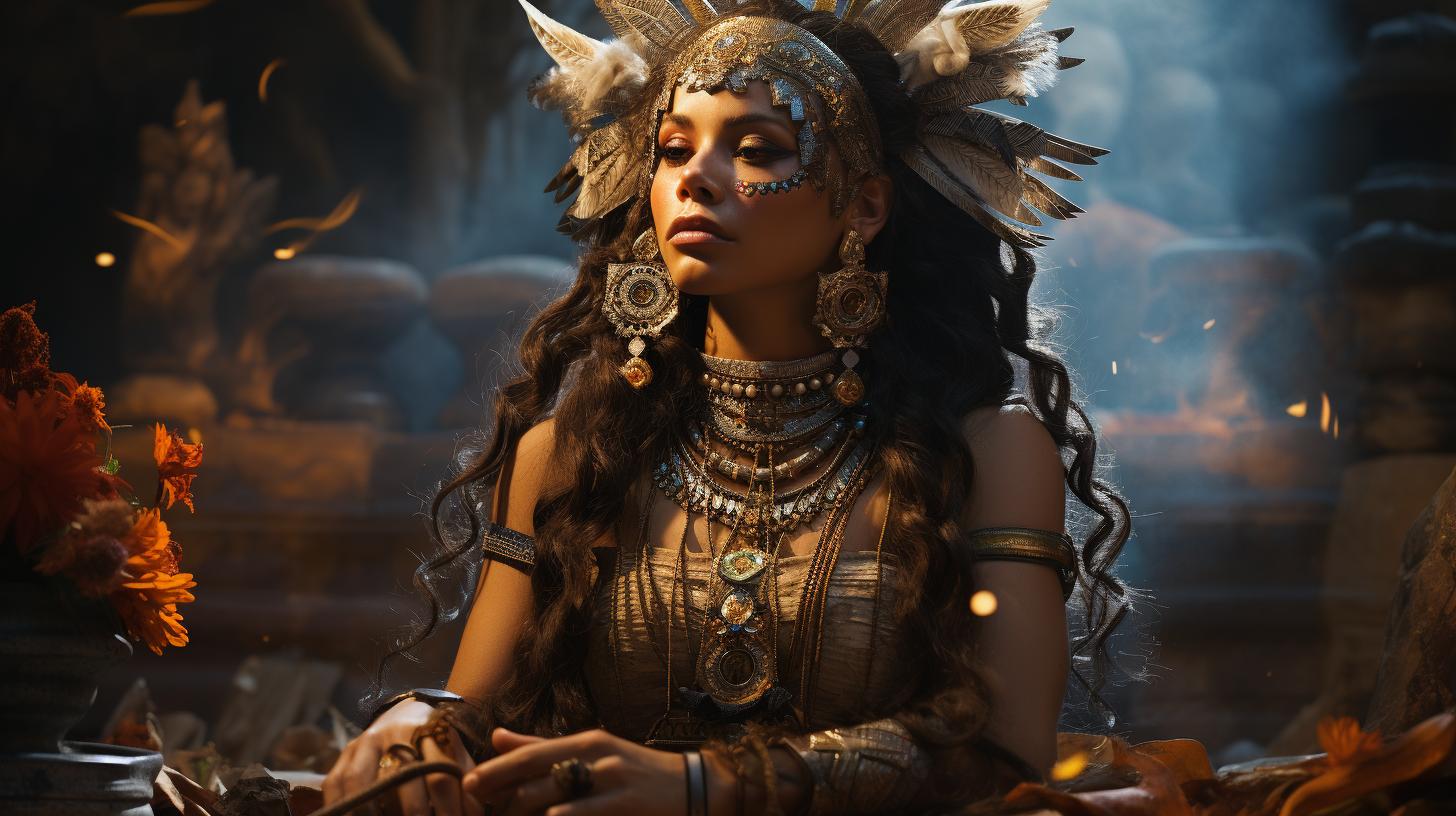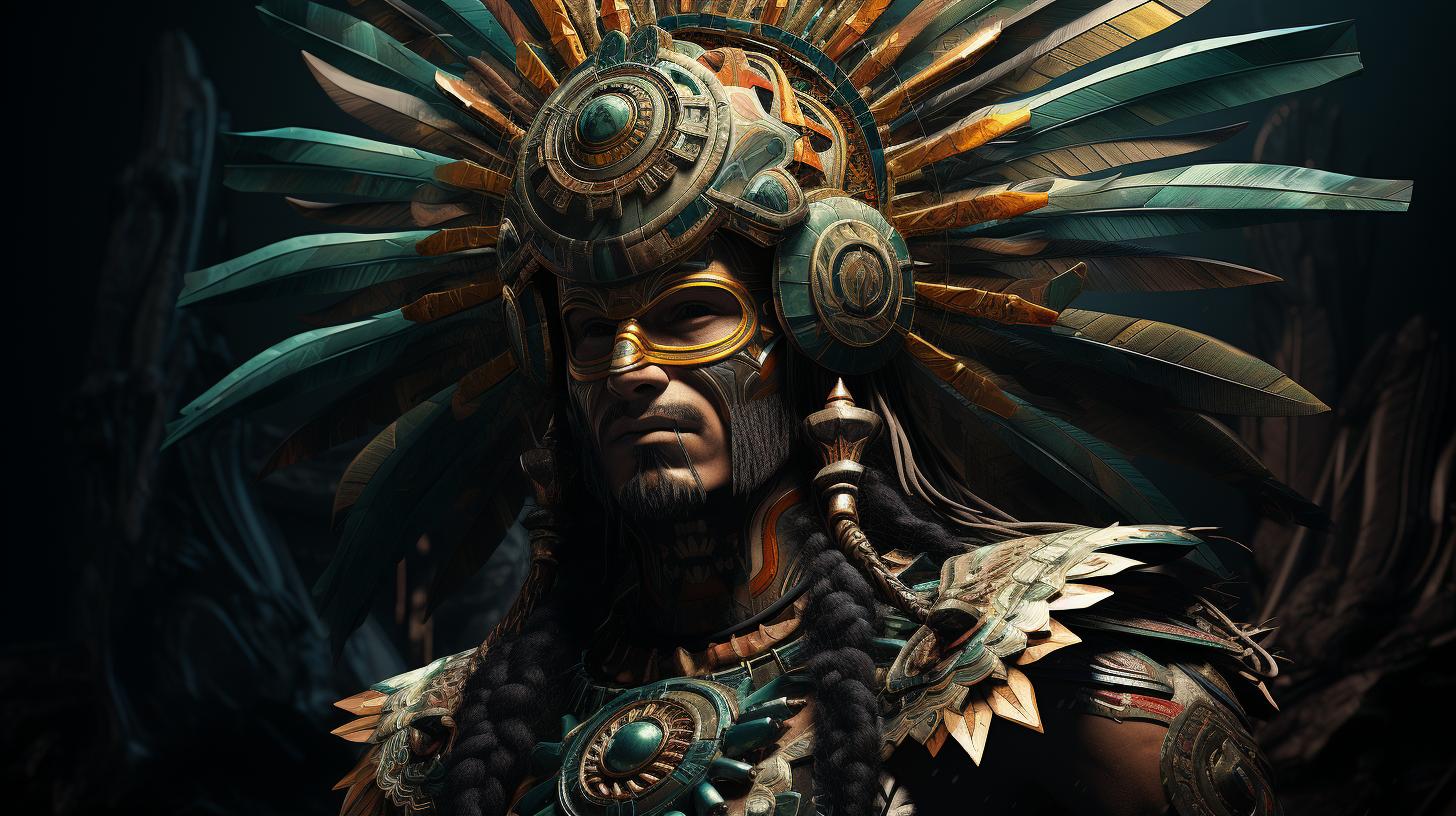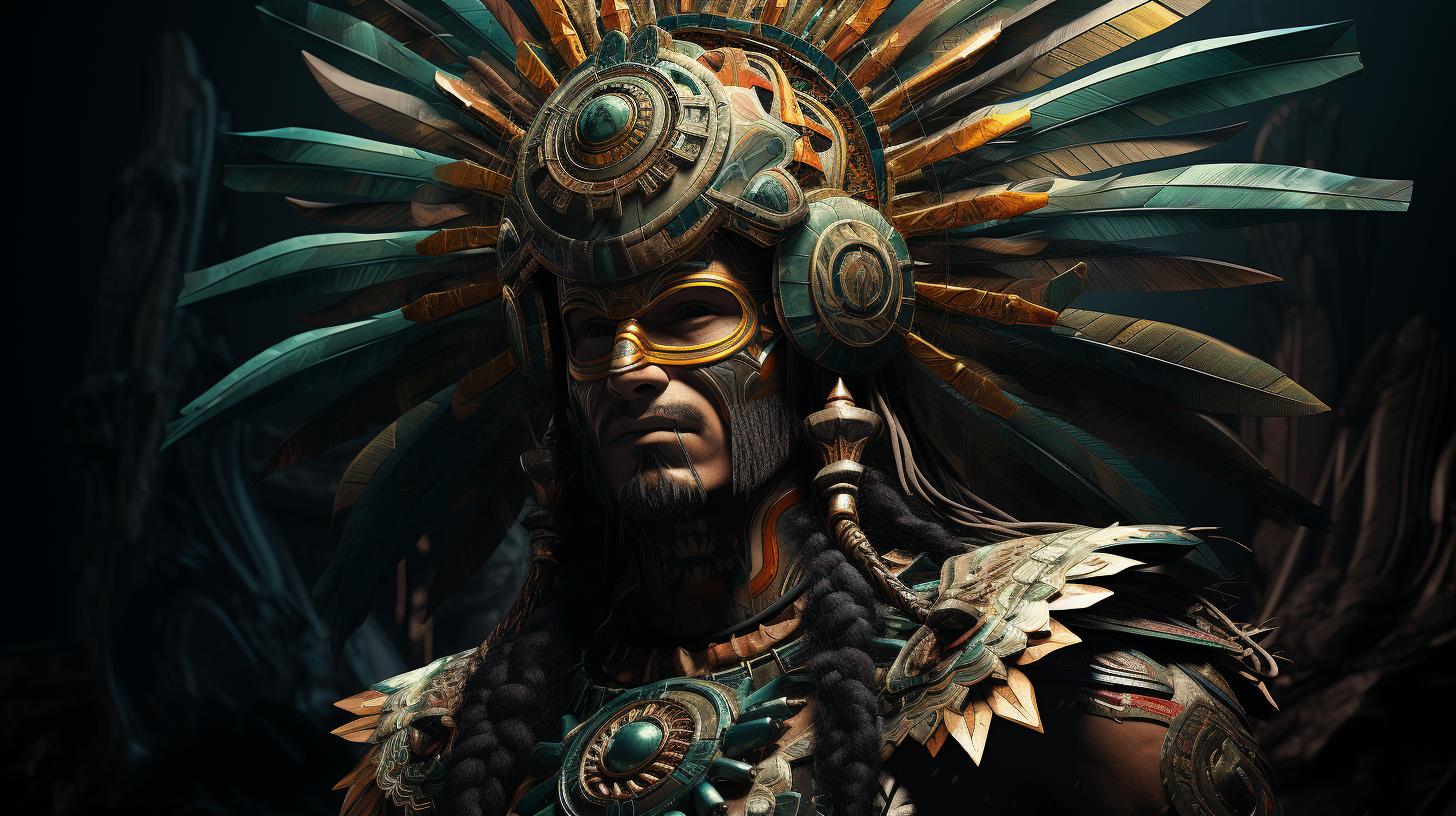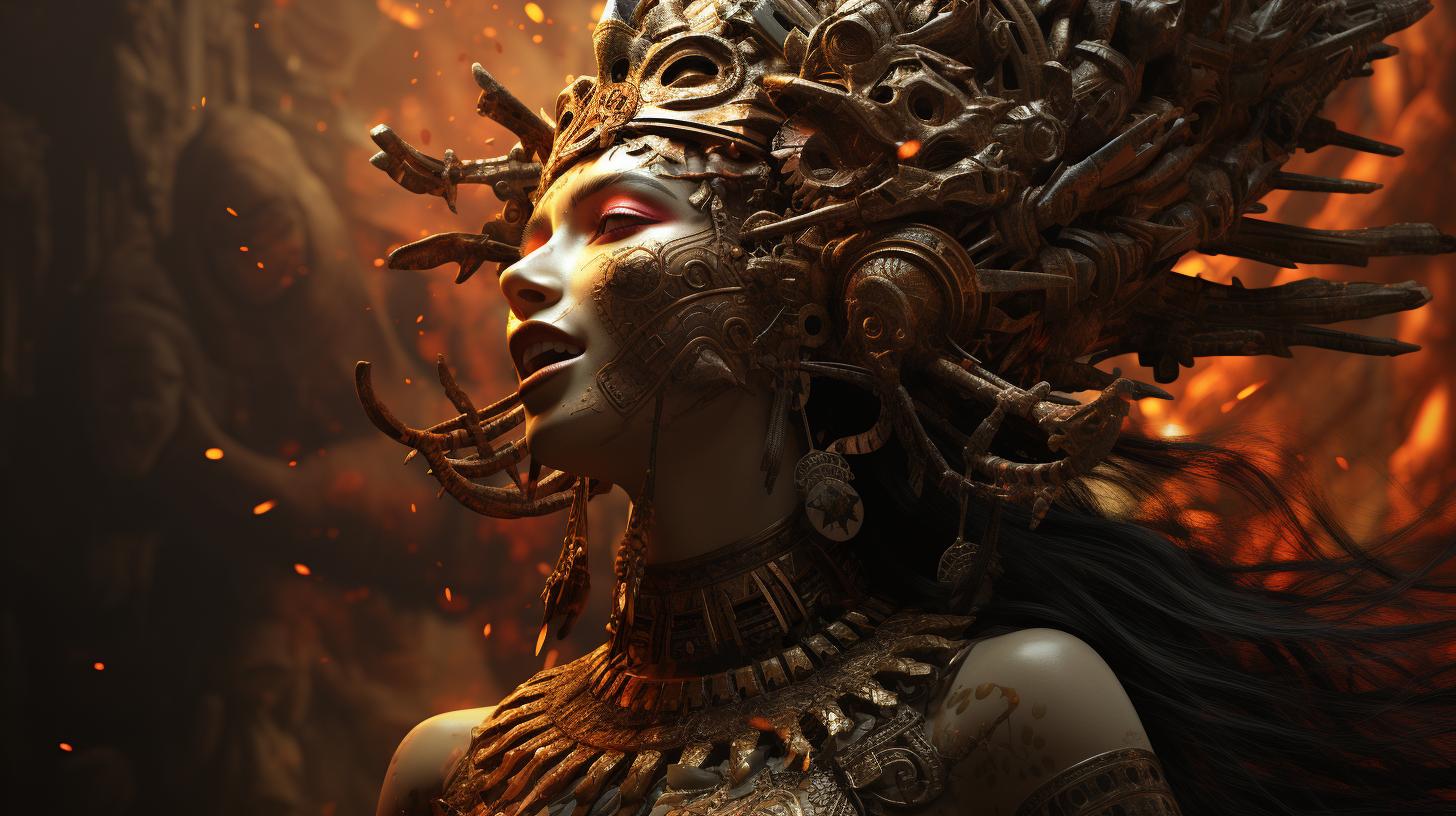Citlalatonac: Exploring the Mythology and Significance of this Aztec Deity
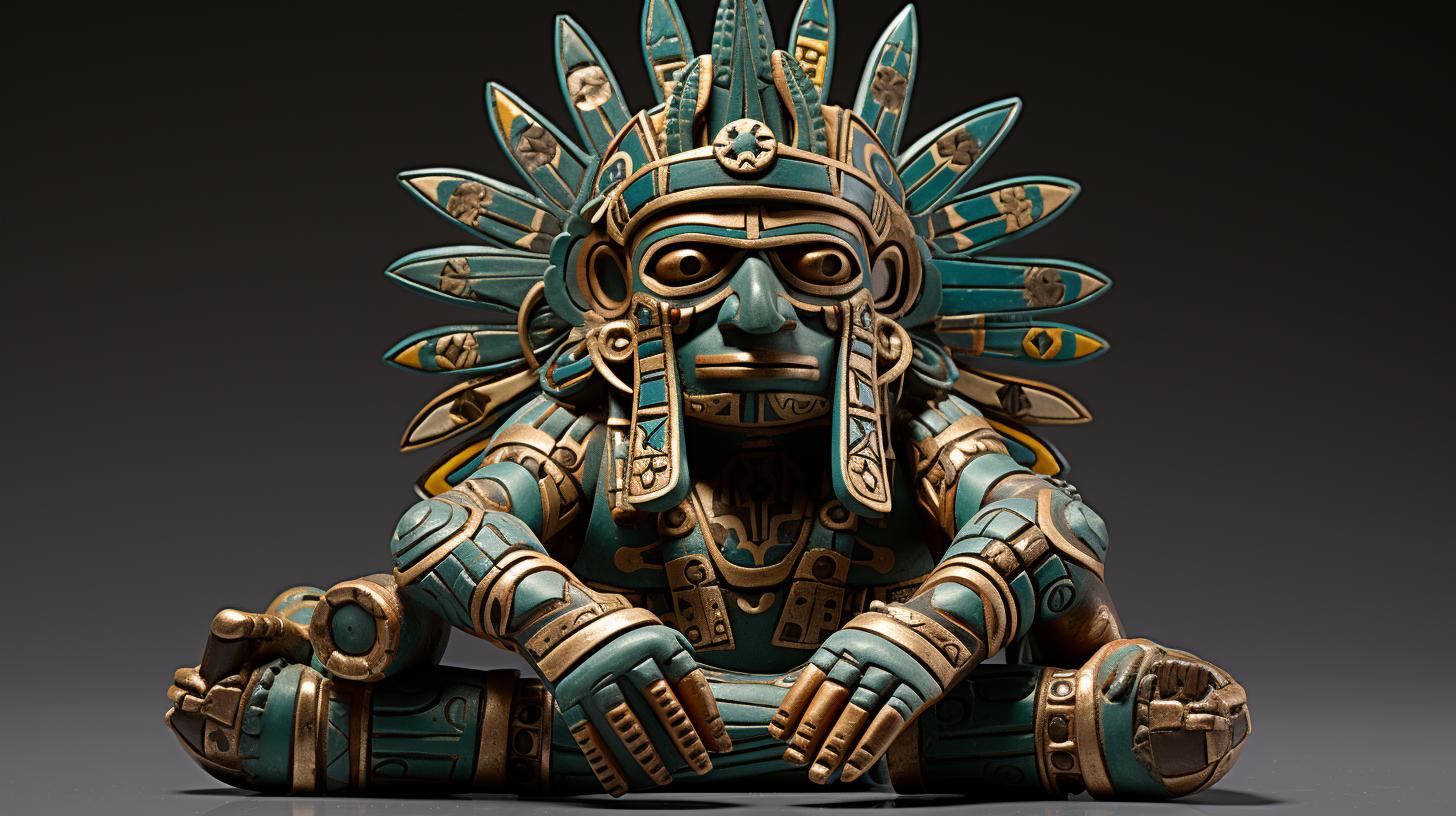
Citlalatonac is a prominent deity in Aztec mythology, associated with the creation of stars. Alongside Citlalicue, the goddess of death and darkness, they are recognized as important figures in Aztec culture.
Their creation of stars is intertwined with the mythology of Nata and Nena, the first human couple. Citlalatonac is also linked to the complex of Ometeotl, and is considered a symbol of light and darkness.
Through their connection to celestial phenomena and the Milky Way, Citlalatonac and Citlalicue hold great significance in Aztec beliefs. In modern culture, their influence and adaptations continue to be explored.
The Aztec Pantheon: Exploring the Gods and Goddesses
The Aztec pantheon is a fascinating and complex framework of gods and goddesses that played significant roles in their culture and mythology. Among these deities, Citlalatonac holds a prominent position as the Aztec god of stars.
Citlalatonac, along with his partner Citlalicue, is believed to have created the stars, symbolizing the celestial beauty and wonder that captivated the Aztec people.
But Citlalatonac is not the only deity worth exploring in the Aztec pantheon. With its rich tapestry of divinities, the pantheon includes a diverse range of gods and goddesses associated with various aspects of life, nature, and the cosmos.
Each deity holds its own significance and mystical attributes, contributing to the intricate belief system of the Aztec civilization.
By delving into the stories, symbolism, and roles of these gods and goddesses, we can gain a deeper understanding of the Aztec worldview and the spiritual forces that shaped their lives.
From Quetzalcoatl, the feathered serpent, to the enigmatic lords of celestial phenomena, the Aztec pantheon offers a captivating journey into a world of divine beings and mythical wonders.
Citlalatonac: The Aztec God of Stars
Citlalatonac, one of the prominent deities in Aztec mythology, holds a significant role as the god of stars.
Revered for their connection to celestial bodies, Citlalatonac is associated with the creation and control of the glittering lights that adorn the night sky.
Within the Aztec pantheon, Citlalatonac is believed to have partnered with Citlalicue, the goddess of death and darkness, to bring forth the stars into existence.
As a divine couple, their union symbolizes the duality of light and darkness, representing the cosmic balance found in the Aztec worldview.
Worship and reverence for Citlalatonac were manifested through rituals and ceremonies aimed at celebrating the brilliance and mystery of the stars.
The Aztecs believed that by paying homage to Citlalatonac, they could gain wisdom and insight into the workings of the universe.
Artistic representations of Citlalatonac often depict the god adorned with celestial motifs, such as stars and the Milky Way.
These artistic depictions served as a visual reminder of Citlalatonac’s association with the celestial realm and their status as a deity of cosmic significance.
As we explore the mythological landscape of the Aztec civilization, understanding the role of Citlalatonac as the god of stars provides us with a glimpse into the celestial beliefs that shaped their worldview and enriched their cultural heritage.
Citlalicue: The Aztec Goddess of Death and Darkness
In Aztec mythology, Citlalicue is revered as the goddess of death and darkness. Associated with the creation of stars, she holds a significant role in the pantheon of Aztec deities.
As the counterpart to Citlalatonac, the god of stars, Citlalicue represents the feminine power and balance in the Aztec cosmology.
Often depicted as a formidable figure, Citlalicue embodies the forces of creation and destruction.
Her association with death indicates her role in the cycle of life, where darkness serves as a necessary counterpart to light. In Aztec beliefs, Citlalicue is intertwined with the natural elements and cosmic forces, influencing the rhythm and order of the universe.
- She is venerated as the goddess of the heavens and the earth.
- Her dominion extends over the stars, the Vía Láctea, and the spiritual realm.
- Citlalicue is often invoked in rituals and ceremonies related to death, rebirth, and the transition between worlds.
Her role as the goddess of death mirrors the duality present in Aztec cosmology, where life and death are interconnected and essential for the continued existence of the world.
With her powers over the celestial realm, Citlalicue represents the ever-present cycle of darkness and renewal, offering insight into the complex Aztec understanding of creation and the afterlife.
Quetzalcoatl: The Feathered Serpent and its Connection to Citlalatonac
In Aztec mythology, Quetzalcoatl is a prominent deity known as the Feathered Serpent.
Quetzalcoatl holds a significant connection to Citlalatonac, the god of stars. This connection can be explored through their roles in the cosmic order and creation myths.
Quetzalcoatl represents the forces of creation and life, while Citlalatonac symbolizes the celestial realm and the stars.
Their intertwined relationship reflects the understanding of how the natural elements are intertwined and shape the universe.
According to Aztec beliefs, Quetzalcoatl played a vital role in the creation of the current era or Sun.
He descended into the underworld to retrieve the bones of the previous age’s inhabitants and brought them back to life by sprinkling his blood on them. This act of rejuvenation mirrors the creation and perpetuation of life itself.
Moreover, Quetzalcoatl’s association with the sun and sky aligns with Citlalatonac’s connection to the stars and celestial phenomena. Their intertwined roles represent the duality of light and darkness, day and night, and the ongoing cycles of cosmic forces.
Through their interplay, Quetzalcoatl and Citlalatonac embody the complex relationships within the Aztec pantheon and highlight the interconnectedness of different aspects of the natural and celestial realms.
The Mythology of Citlalatonac and Citlalicue
In Aztec mythology, Citlalatonac and Citlalicue are revered as important deities with a significant role in their cosmology.
They are known for their creation of stars, a celestial feat that showcases their power and influence. Citlalatonac, the god of stars, is often depicted as a representation of light and darkness, embodying the celestial luminosity and the earthly shadows.
Citlalicue, on the other hand, is the goddess associated with death and darkness, emphasizing the cyclical nature of life.
Together, Citlalatonac and Citlalicue are believed to have played a crucial part in the formation of the stars, illuminating the night sky with their divine touch.
The mythology surrounding them connects them not only to the celestial realm but also to human existence. They are often linked to Nata and Nena, the first human couple in Aztec mythology, symbolizing the interconnectedness of the divine and mortal realms.
The story of Citlalatonac and Citlalicue exemplifies the rich and complex belief system of the Aztec culture, showcasing their profound understanding of the celestial forces and their reverence for the cycles of life and death.
Exploring their mythology allows us to delve deeper into the intricate tapestry of Aztec cosmology and appreciate the significance of these deities in shaping their worldview.
Aztec Cosmology: The Creation of Stars by Citlalatonac and Citlalicue
In Aztec cosmology, Citlalatonac and Citlalicue play a vital role in the creation of stars.
According to Aztec mythology, these deities are credited with bringing forth the celestial bodies that adorn the night sky. Citlalatonac, the god of stars, and Citlalicue, the goddess associated with death and darkness, joined forces to give birth to the stars, making them incredibly important figures in Aztec cosmology.
Aztec cosmology viewed the cosmos as a series of layers or levels, with each level representing different aspects of existence. Citlalatonac and Citlalicue were regarded as creators of stars and were associated with the celestial realm.
The stars were seen as divine entities, and their creation by these deities brought light and guidance to the world.
This belief in the role of Citlalatonac and Citlalicue in the creation of stars showcases the complex and intricate nature of Aztec cosmology.
The Aztecs held a deep reverence for celestial phenomena, viewing them as manifestations of divine power and wisdom. Understanding the role of these deities in Aztec cosmology provides insights into the intricate belief system and celestial reverence of the ancient Aztec civilization.
- The deities Citlalatonac and Citlalicue are central to Aztec cosmology.
- They are believed to have created the stars, illuminating the night sky.
- The creation of stars by these deities showcased their importance in Aztec belief and reverence for celestial phenomena.
Nata and Nena: The First Human Couple in Aztec Mythology
In Aztec mythology, Nata and Nena hold a significant place as the first human couple.
According to Aztec creation stories, they were created by the deity Citlalatonac and his wife Citlalicue. Nata and Nena are seen as the ancestors of all humankind, symbolizing the origin of the human race.
The story goes that Citlalatonac and Citlalicue created Nata and Nena and placed them on Earth, providing them with the responsibility of populating and sustaining the world. Nata represents the male figure, while Nena represents the female figure, embodying the duality and balance present in the universe.
Nata and Nena’s role in Aztec mythology extends beyond their status as the first human couple. They are also associated with the gods and goddesses of the Aztec pantheon, serving as a link between the divine and human realms.
Their creation by Citlalatonac and Citlalicue exemplifies the interconnectedness between the celestial and earthly realms.
The story of Nata and Nena showcases the Aztec belief in the creation and preservation of life, with their existence serving as a testament to the rich cultural and spiritual heritage of the Aztec civilization.
Citlalatonac’s Role in the Complex of Ometeotl
In the Aztec pantheon, Citlalatonac holds a significant role within the complex of Ometeotl, the supreme deity representing duality and unity. As one of the primordial gods, Citlalatonac represents the light and darkness, the celestial and terrestrial realms.
With their spouse, Citlalicue, they are believed to have created the stars, symbolizing the divine presence in the cosmos.
As part of the complex of Ometeotl, Citlalatonac embodies the cosmic forces that govern the universe.
They are regarded as a manifestation of Tonacatecuhtli, the lord of the thirteen heavens. Through their association with celestial bodies and the Milky Way, Citlalatonac represents the connection between the divine and earthly realms.
While Citlalatonac did not have a dedicated cult, their role in Aztec mythology showcases their profound importance. They symbolize the interplay between light and darkness, the balance between celestial and earthly forces.
The worship of Citlalatonac and their connection to the complex of Ometeotl underline the intricate cosmology and belief system of the Aztecs.
Exploring the role of Citlalatonac offers valuable insights into the cosmic interdependencies within Aztec mythology, shedding light on the profound metaphysical beliefs held by the ancient civilization.
Citlalatonac and Citlalicue: Symbols of Light and Darkness
In Aztec mythology, Citlalatonac and Citlalicue are not only associated with the creation of stars, but they also embody the essential concepts of light and darkness. Citlalatonac represents the brilliant light that illuminates the sky, symbolizing the power and radiance of the sun.
On the other hand, Citlalicue personifies the enveloping darkness, signifying the night and the mysterious realms of the underworld.
To the Aztecs, the interplay between light and darkness was of paramount importance, reflecting the constant cycle of life and death.
Through Citlalatonac and Citlalicue, this eternal dance of opposing forces was personified. Their combined presence brought balance and harmony to the cosmos, showing the intricate connection between light and darkness in the natural order of the Aztec worldview.
Within their symbolism, Citlalatonac and Citlalicue also embody the duality present in various aspects of life. Light represents vitality, warmth, and growth, while darkness symbolizes mystery, transformation, and renewal. Their intertwined essence speaks to the cyclical nature of existence, where light and darkness are inextricably linked and continually give rise to one another.
Understanding the significance of Citlalatonac and Citlalicue as symbols of light and darkness provides insight into the depth and complexity of Aztec mythology. Their embodiment of opposing yet complementary forces adds a profound layer of meaning to the cosmic tapestry woven by the gods and goddesses of ancient Mesoamerica.
The Significance of Citlalatonac in Aztec Culture
Citlalatonac holds immense importance in Aztec culture, representing a pivotal figure in their mythology and belief system. As the god of stars, Citlalatonac symbolizes the celestial realm and the mysteries of the cosmos.
In Aztec cosmology, stars were considered divine manifestations, and their creation by Citlalatonac and Citlalicue was a significant part of the creation narrative.
But Citlalatonac goes beyond being just a deity associated with stars.
This god also embodies the duality of light and darkness, representing the celestial bodies that illuminate the night sky. Citlalatonac’s association with the sun and moon further solidifies their role as a bridge between the earthly and divine realms.
Furthermore, Citlalatonac is regarded as one of the embodiments of Tonacatecuhtli, the lord of the thirteen heavens. This highlights their connection to the vast cosmos and their elevated status among the gods.
While Citlalatonac did not have a dedicated cult, their significance in Aztec mythology is undeniable.
The mythology surrounding Citlalatonac enriches our understanding of Aztec culture and their perception of the universe.
They inspire awe and curiosity, inviting us to ponder the mysteries of the stars and our place within the grand tapestry of existence.
- Citlalatonac represents the divine creation of stars and the celestial realm.
- They embody the duality of light and darkness, symbolizing the sun, moon, and celestial bodies.
- Citlalatonac is associated with Tonacatecuhtli, the lord of the thirteen heavens.
- Their importance in Aztec culture reflects the significance placed on the cosmos and its mysteries.
Exploring the Symbolism of the Milky Way in Aztec Mythology
In Aztec mythology, the Milky Way holds deep symbolic significance.
Referred to as Citlalixiptli, “the trail of the stars,” it is associated with the divine couple, Citlalatonac and Citlalicue. The Aztecs believed that the Milky Way was formed by the overflowing celestial milk of Citlalicue, representing her nurturing and life-giving qualities.
The Milky Way was seen as a pathway that connected the earthly realm with the spiritual realm. It was believed to be the path that souls took after death, guiding them to their final resting place.
This cosmic pathway represented the continuity of life and the cycle of death and rebirth.
The Aztecs also associated the Milky Way with Citlalicue’s role as the goddess of the underworld and death.
It represented the darkness and mystery of the afterlife, as well as the transformative power of death and rebirth.
Furthermore, the Milky Way symbolized the eternal dance between light and darkness, a concept deeply ingrained in Aztec cosmology.
It served as a reminder of the delicate balance between opposing forces and the interconnectedness of all things.
- The Milky Way, known as Citlalixiptli, represents the celestial milk of Citlalicue.
- It serves as a cosmic pathway between the earthly and spiritual realms.
- It guides souls to the afterlife and symbolizes the cycle of death and rebirth.
- The Milky Way represents the darkness and transformative power of death.
- It symbolizes the eternal dance between light and darkness.
Citlalatonac and Citlalicue: Lords of Celestial Phenomena
Citlalatonac and Citlalicue, two important deities in Aztec mythology, hold dominion over celestial phenomena.
Often referred to as the Lords of Celestial Phenomena, they are closely associated with the creation of stars and their connection to the earthly realm. Acting as cosmic forces, Citlalatonac and Citlalicue are believed to have crafted the stars, filling the night sky with their divine radiance.
As celestial beings, they are revered as symbols of power and awe, embodying the dualities of light and darkness, day and night.
In Aztec cosmology, Citlalatonac and Citlalicue are also strongly linked to the Milky Way, known as Coixtlahuacan, which is seen as a celestial river flowing across the night sky.
This celestial river, with its gleaming stars, represents the divine connection between the earthly realm and the spiritual world. Citlalatonac and Citlalicue’s association with the Milky Way further emphasizes their significance as Lords of Celestial Phenomena.
Their role in Aztec mythology extends beyond their celestial creations. Citlalatonac and Citlalicue are often depicted in ancient art and murals, showcasing their importance in Aztec culture and beliefs. Their representation as divine entities reflects the Aztec people’s profound understanding and reverence for the celestial realm and its influence on human existence.
The enduring legacy of Citlalatonac and Citlalicue as the Lords of Celestial Phenomena highlights their symbolic significance in Aztec cosmology and their lasting impact on the culture and spirituality of ancient Mesoamerica.
Citlalatonac: Representations and Depictions in Aztec Art
In Aztec art, Citlalatonac is often portrayed as a powerful deity, symbolizing the celestial realm and the creation of stars. Artists depicted Citlalatonac using various visual elements that conveyed their importance and mythical attributes.
The representations of Citlalatonac in Aztec art commonly show a figure adorned with celestial symbols, such as speckled patterns resembling stars and the iconic image of the Milky Way. These visual cues highlight Citlalatonac’s association with the stars and the cosmic realm.
Furthermore, Citlalatonac is often depicted in a regal and majestic manner, reflecting their status as a prominent deity. They can be shown wearing elaborate headdresses, adorned with feathers and celestial motifs, symbolizing their connection to the heavens.
Aztec artists also portrayed Citlalatonac alongside their spouse Citlalicue, emphasizing their partnership in creating the stars and their pivotal role in the cosmic order. This depiction reinforces the mythological narrative of their joint creation and their significance in Aztec belief systems.
The representation of Citlalatonac in Aztec art serves as a visual testament to their importance in Aztec culture and their role in the realm of the celestial. These artistic depictions not only showcase the skill and creativity of Aztec artists but also provide insights into the religious and mythological beliefs of the ancient Aztec civilization.
Citlalatonac: Unveiling the Mysteries of this Aztec Deity
Delve into the intriguing world of Citlalatonac, an enigmatic figure in Aztec mythology. As the god of stars, Citlalatonac holds a significant role in the celestial pantheon. This section explores the captivating aspects surrounding this deity, aiming to shed light on the lesser-known details.
Discover the rich symbolism associated with Citlalatonac’s representation of light and darkness, and its connection to the moon, sun, and the majestic Milky Way. Unravel the mythological narratives that intertwine Citlalatonac’s creation of stars alongside its companion, Citlalicue, the goddess of death and darkness.
- Uncover the parallels between Citlalatonac and the first human couple, Nata and Nena, as they play integral roles in Aztec cosmology.
- Explore the deity’s significance within the complex of Ometeotl, where it stands as a crucial part of the gods and primordial humans of creation.
- Marvel at Citlalatonac’s intricate representations in Aztec art, offering visual cues to its celestial attributes and mythological significance.
Join us on this journey of exploration as we peel back the layers of mystery surrounding Citlalatonac, unearthing the profound cultural and cosmic significance embedded within this Aztec deity.
Citlalatonac in Modern Culture: Influence and Adaptations
In modern culture, the influence of Citlalatonac can be seen in various forms. From literature to art, this Aztec deity has captured the imagination of many.
1. Literature: Citlalatonac’s portrayal as the god of stars has inspired numerous literary works.
From poems to novels, authors often explore the themes of light, darkness, and celestial phenomena associated with this deity.
2. Art: Citlalatonac’s representation in art showcases the rich symbolism and intricate details of Aztec mythology.
Paintings, sculptures, and murals depict the god adorned with celestial elements, emphasizing their significance in the cosmic order.
3. Pop Culture: Citlalatonac’s mythological legacy has made its way into popular culture.
From movies to video games, references to this deity and their connection to creation and celestial phenomena can be found, adding depth and intrigue to these contemporary mediums.
4. Fashion and Design: The celestial imagery associated with Citlalatonac has also influenced fashion and design.
Celestial patterns, star motifs, and cosmic-inspired collections often draw inspiration from the symbolism and aesthetic of this Aztec god.
5. Cultural Celebrations: Citlalatonac’s role as a deity associated with stars and celestial bodies has led to their inclusion in cultural celebrations and festivals.
Events showcasing Aztec traditions and mythology often feature artistic representations and performances that pay homage to this significant deity.
As we continue to explore and appreciate the rich cultural heritage of the Aztec civilization, Citlalatonac’s influence and adaptations in modern culture serve as a testament to their enduring significance and the fascination they continue to evoke.
.











